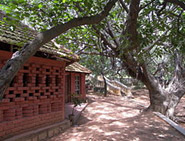
Institutions

Kalakshetra Foundation
Kalakshetra is a vital centre of training and performance. The institution boasts of having produced and moulded generations of acclaimed artists in a distinctive style. Since its establishment in the early 20th century Kalakshetra has had stalwart musicians and dancers on its faculty.
Kalakriti
Kalakriti is new born organization that commenced its work in 2008-2009. Kalakriti constitutes groups of tribal artisans, craftsmen and women. Kalakriti is working in small and undeveloped rural areas where there are no facilities such as transport etc. and where the communities practice traditional crafts that use material such as natural paint, stone etc without any chemical substitutes.
Kala Raksha Trust
Kala Raksha Trust, based at Sumrasar Sheikh, 25km north of Bhuj, aims to preserve and promote Kutch arts, and specialises in Suf, Rabari and Garasia Jat embroidery. The trust has a small museum, works with nearly 1000 artisans from seven different communities and can arrange visits to villages to meet artisans and see them at work. KALARAKSHA or "Art Preservation" as the name implies aims to preserve traditional arts of the region by making them culturally and economically viable. The Trust provides training as needed to make this possible. The KALA RAKSHA project began in Kutch in 1991. It focused on a group of embroiderers in Sumrasar Sheikh, a village 25 km north of Bhuj. These people had migrated from Nagar Parkar in Sindh in 1972, bringing with them some fine traditional embroidery as well as their skills in suf and kharek embroidery styles.
Contributed by Prarthana, CEE, Ahmedabad
Kangra Arts Promotion Society (KAPS)
Kangra Arts Promotion Society (KAPS) is a non- governmental organisation, working for the promotion of arts in Kangra and surrounding areas that were once ruled by the Kangra Dynasty.
Karnataka Chitrakala Parishath

Karnataka Chitrakala Parishath (KCP) is an Art Complex, operating in Bangalore from past five decades as the leading Center for Visual Arts. It is a landmark for visual culture. It comprises of a network of Museums, Galleries, Archive that stores pan-Indian Visual Culture that includes Folk, Traditional, Modern and Contemporary Art and Artists.
Kerala Folklore Academy
The Kerala Folklore Academy was established at Chirakkal in Kannur in 1995 by the Government of Kerala and functions under the aegis of the Cultural Affairs Department. Its mission is to promote and preserve the traditional art forms of Kerala. It helps promote all ritual art forms of Kerala.
Kerala Lalithakala Akademi
Kerala Lalithakala Akademi is an autonomous institution of the Government of Kerala established in 1962, with the objective of conserving and promoting the visual arts: painting, sculpture, architecture and graphics. It has had a line of illustrious artists at its helm, starting with M Ravi Varma Raja, son of Raja Ravi Varma the great artist, as its first chairman.
Kerala Sangeetha Nataka Akademi
Kerala Sangeetha Nataka Akademi was established in 1958 through the pioneering efforts of the first elected Chief Minister of Kerala, Shri EMS Namboorthiripad, as a government agency to encourage, document and preserve the rich legacy of the varied art forms of Kerala.
Khamir
KHAMIR stands for Kachchh Heritage, Art, Music, Information and Resources. KHAMIR is a platform for the crafts, culture, heritage and ecology of the Kachchh region of Gujarat. The organisation works to reposition craft and folk music in Kachchh and to revitalize Kachchh's creative industries. Instituted after the earthquake of 2001, it is a space for engagement and development of Kachchh's rich creative industries.
Contributed by Prarthana, CEE, Ahmedabad
Khuda Bakhsh Oriental Public Library
Close to the banks of the Ganges, in Patna, stands the Khuda Bakhsh Oriental Public Library, a unique repository of about 21000 oriental manuscripts and 2.5 lakh printed books. It was opened for public in October, 1891 by the illustrious son of Bihar Khan Bahadur Khuda Bakhsh with 4,000 manuscripts, of which he inherited 1,400 from his father Maulvi Mohammed Bakhsh.
Kumbham: Reviving vanishing crafts
Kumbham is "the story of an artisan village recapturing the craft they had almost lost, and redefining it for the contemporary world". Set up in 1993 by KB Jinan in Aruvacode, near Nilambur of Malappuram district of Kerala, Kumbham aimed to revive the craft of the potter community of this region which was almost extinct due to its inability to survive competitively in the modern market.


